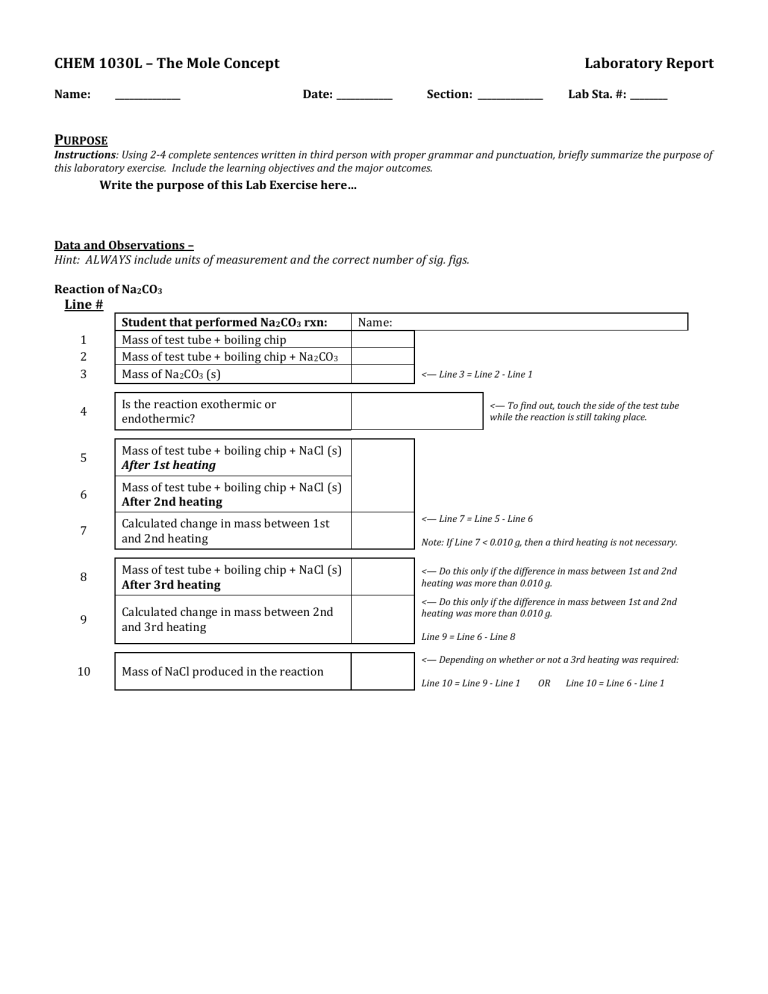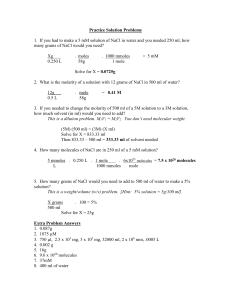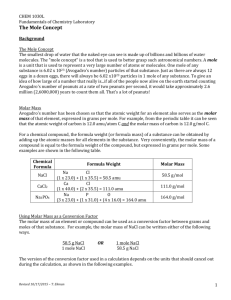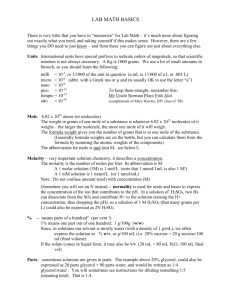Mole LabReport

CHEM 1030L – The Mole Concept
Name: ______________ Date: ____________ Section: ______________
Laboratory Report
Lab Sta. #: ________
P
URPOSE
Instructions: Using 2-4 complete sentences written in third person with proper grammar and punctuation, briefly summarize the purpose of this laboratory exercise. Include the learning objectives and the major outcomes.
Write the purpose of this Lab Exercise here…
Data and Observations –
Hint: ALWAYS include units of measurement and the correct number of sig. figs.
Reaction of Na
2
CO
3
Line #
Name:
1
2
3
Student that performed Na
2
CO
3
rxn:
Mass of test tube + boiling chip
Mass of test tube + boiling chip + Na
2
CO
3
Mass of Na
2
CO
3
(s) <— Line 3 = Line 2 - Line 1
4
Is the reaction exothermic or endothermic?
<— To find out, touch the side of the test tube while the reaction is still taking place.
5
6
7
Mass of test tube + boiling chip + NaCl (s)
After 1st heating
Mass of test tube + boiling chip + NaCl (s)
After 2nd heating
Calculated change in mass between 1st and 2nd heating
<— Line 7 = Line 5 - Line 6
Note: If Line 7 < 0.010 g, then a third heating is not necessary.
8
Mass of test tube + boiling chip + NaCl (s)
After 3rd heating
<— Do this only if the difference in mass between 1st and 2nd heating was more than 0.010 g.
9
Calculated change in mass between 2nd and 3rd heating
<— Do this only if the difference in mass between 1st and 2nd heating was more than 0.010 g.
Line 9 = Line 6 - Line 8
10 Mass of NaCl produced in the reaction
<— Depending on whether or not a 3rd heating was required:
Line 10 = Line 9 - Line 1 OR Line 10 = Line 6 - Line 1
Reaction of NaHCO
3
Line #
11
12
Student that performed NaHCO
3
rxn: Name:
Mass of test tube + boiling chip
Mass of test tube + boiling chip + NaHCO
3
13 Mass of NaHCO
3
(s)
14
Is the reaction exothermic or endothermic?
15
Mass of test tube + boiling chip + NaCl (s)
After 1st heating
<— Line 13 = Line 12 - Line 11
<— To find out, touch the side of the test tube while the reaction is still taking place.
16
17
Mass of test tube + boiling chip + NaCl (s)
After 2nd heating
Calculated change in mass between 1st and 2nd heating
<— Line1 7 = Line 15 - Line 16
Note: If Line 17 < 0.010 g, then a third heating is not necessary.
18
19
Mass of test tube + boiling chip + NaCl (s)
After 3rd heating
Calculated change in mass between 2nd and 3rd heating
<— Do this only if the difference in mass between 1st and 2nd heating was more than 0.010 g.
<— Do this only if the difference in mass between 1st and 2nd heating was more than 0.010 g.
Line 19 = Line 16 - Line 18
20 Mass of NaCl produced in the reaction
<— Depending on whether or not a 3rd heating was required:
Line 20 = Line 19 - Line 11 OR Line 20 = Line 16 - Line 11
Q
UESTIONS AND
A
NALYSIS
I
NSTRUCTIONS
: Using one or more complete sentences written in third person with proper grammar and punctuation, briefly respond to the following questions.
Hint: Remember that points are awarded for each aspect of the question.
1.
Reaction of Na
2
CO
3
with HCl a.
Write a balanced chemical equation for the reaction of HCl with Na
2
CO
3
. Include phase labels.
Type the response here... b.
Theoretical mole ratio: Based on the balanced chemical equation above, how many moles of NaCl are produced per mole of Na
2
CO
3
that react? Hint: Replace
blanks in the mole conversion factor with the correct number. c.
Experimental mole ratio: How many moles of NaCl were produced per mole of
Na
2
CO
3
that reacted (Calculation 5)? Hint: Replace the blank in the mole
conversion factor with the correct number.
____ mol NaCl
____ mol Na
2
CO
____ mol NaCl
2.
Reaction of NaHCO
3
with HCl
1 mol Na a.
Write a balanced chemical equation for the reaction of HCl with NaHCO3. Include phase labels.
2
CO
3
3
Type the response here... the b.
Theoretical mole ratio: Based on the balanced chemical equation above, how many moles of NaCl are produced per mole of NaHCO3 that react? Hint: Replace blanks in the mole conversion factor with the correct number. the
____ mol NaCl
____ mol NaHCO
3
c.
Experimental mole ratio: How many moles of NaCl were produced per mole of
NaHCO
3
that reacted (Calculation 10)? Hint: Replace the blank in the mole
conversion factor with the correct number.
____ mol NaCl
1 mol NaHCO
3
3.
Compare the theoretical and actual ratios from questions 1 and 2, above. How closely do the experimental ratios agree with the actual ratios. Do the experimental results "prove" that the mole concept works?
Type the response here...
4.
What was the percent yield of NaCl? If the percent yield was greater than 100%, describe at least two causes for a high percent yield. If the percent yield was lower than 100%, describe at least two causes for low percent yield. In the very unlikely event that the percent yield was EXACTLY 100%, describe at least two causes for either a low or high percent yield.
Type the response here...
5.
Was the reaction of HCl with Na
2
CO
3
exothermic or endothermic? This conclusion is based on what observation?
Type the response here...
6.
Was the reaction of HCl with NaHCO
3
exothermic or endothermic? This conclusion is based on what observation?
Type the response here...
C
ONCLUSION
I
NSTRUCTIONS
: Write an essay, using complete sentences written in third person with proper grammar and punctuation, to briefly summarize (1) the purpose of this laboratory exercise, (2) the work performed, (3) any problems encountered and how they could affect the results, and the deliverables (percent yield for each reaction and molar ratios found for each reaction).
Use paragraphs to separate major ideas, however, do not number the paragraphs.
Type the response here...









